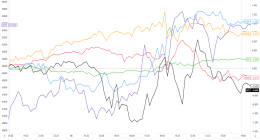
To anyone who happened to be looking up that morning, perhaps from the deck of a boat off the coast of Portsmouth, New Hampshire, the plane would have appeared to be on an extremely alarming trajectory. It rocketed into the cloudless late-summer sky at a 45-degree angle, slowed momentarily and leveled out, then nosed down toward the ocean, plunging 17,000 vertical feet in a matter of seconds. At the last moment, it leveled out again and began another climb, looking for all the world as though it were being piloted by a hopelessly indecisive hijacker.
Onboard the plane, the mood was euphoric and a little hysterical. The main cabin had been converted into a kind of padded cell, lined with soft white tiles in lieu of seats and overhead bins. Two dozen passengers, clad in blue jumpsuits, lay on their backs on the floor. As the plane neared the crest of its first roller-coaster wave, a member of the flight crew got on the PA. “Pushing over, slow and easy,” he shouted over the roar of the engines. “Release!” Moments before he uttered that final word, the passengers began to levitate. Their feet, hands, and hair lifted first, then their bodies, arms dog-paddling and legs kicking ineffectually as they giggled and grinned like fools for a fleeting, floating instant. “Feet down, coming out,” the crew member said 20 seconds later. The passengers hit the floor ass first and lay spread-eagled, staring at the ceiling.
The plane flew 20 parabolic arcs that day, for a total of around six minutes of weightlessness. Each time gravity loosened its grip, the blue-suited occupants frantically got to work on a range of activities and experiments. I hovered in the middle of the cabin, toes down, hair up, and took in the scene. Up by the cockpit, a square-jawed jock raced to strap himself into a vertical rowing machine. Not far away, a waifish young woman sculpted spidery 3D figures in midair with a hot glue gun, sucking on her lip piercing with a look of deep concentration. Behind me, toward the rear of the fuselage, the world’s first musical instrument designed exclusively for performance in microgravity—a sort of metallic octopus called the Telemetron—emitted plaintive digital chimes as it spun. A woman wearing a seahorse-inspired robotic tail rotated serenely, twirling around its flexible ballast like a stripper on a pole.
A few feet away from where I hung, Cady Coleman, a former NASA astronaut with six months of spaceflight experience, took a nostalgic joyride, somersaulting and gliding like a pro. Nearby, silkworms in varying stages of development bounced gently in the hammock of their freshly woven cocoons, largely unnoticed inside a small acrylic box. I struggled to keep hold of my pencil and notebook as I watched industrial designer Maggie Coblentz, immaculately costumed in a Ziggy Stardust-inspired white jumpsuit and matching go-go boots, chase down and swallow a handful of boba pearls, nibbling at them like a goldfish.
The flight had been chartered by Ariel Ekblaw, the intimidatingly accomplished founder of the MIT Media Lab’s Space Exploration Initiative. Ekblaw has a round face, long curls, and the earnest demeanor that comes with being a Girl Scout Gold Award winner and high school valedictorian. Her mother set the bar for overachievement in a male-dominated field: She was a reservist instructor in the US Air Force back when female trainers were unheard of, and she would have flown fighter jets if women had been allowed to at the time. But it was Ekblaw’s father, a fighter pilot himself, who kindled her obsession with space. He was a sci-fi buff, and Ekblaw grew up devouring his paperback copies of Isaac Asimov and Robert Heinlein. She also watched Star Trek: The Next Generation at a formative age, imprinting on its impossibly optimistic vision of the future. After majoring in physics, math, and philosophy as an undergrad, she earned a master’s degree in blockchain research. Then, four years ago, at the age of 23, she decided to return to her first love.
The Space Exploration Initiative’s goal is to bring together “artists, scientists, engineers, and designers to build a real-life Starfleet Academy.” Ekblaw and her expanding team of more than 50 collaborators are getting ready for the day when humanity becomes a space-native civilization, as comfortable in the cosmos as we have been on Earth. “People say we’re putting the cart before the horse,” Ekblaw concedes. “But the complexities of space are such that we really should be at least designing the cart while the horse is being prepared.”
As the billionaire rocket bros never tire of reminding us, we stand on the cusp of a new era of space travel. In the coming decades, there will be celestial cruises aboard Richard Branson’s Virgin Galactic. There may be off-world factories and lunar mining operations, courtesy of Jeff Bezos and Blue Origin. There will probably be hydroponic grow houses at Elon Musk’s SpaceX colony on Mars. Even the bureaucrats at NASA have grand plans for the future. But while a new generation of aerospace engineers toils over the tech that will get us into orbit and beyond—reusable launch vehicles, rocket-bearing planes—an important question remains unanswered, Ekblaw says: “What will delight humans in space?”
Even in the near term, this is not a frivolous concern. A one-way trip to Mars will take about nine months, which is a long time to spend inside a hermetically sealed tube hurtling through a cold, dark void. Like all animals, humans require stimulation; without something to break the monotony, most of us end up like a tiger pacing its cage—stressed, depressed, and prone to problematic behaviors. Indeed, many scientists believe that boredom is one of the most serious challenges facing future spacefarers.







